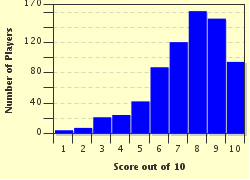Quiz Answer Key and Fun Facts
1. The Thomson's gazelle is one of the most common types of gazelle found in areas of eastern Africa and is capable of running at speeds of 50 to 60mph. Unfortunately its main predator is which type of speedy big cat, the fastest land mammal in the world?
2. Mammals of the suborder Vermilingua are native to Central and South America and are characterised by their long snout and thin extendable tongue. By what common name, derived from their choice of diet, are they generally known?
3. Which type of weasel, often known as 'ermine' when it has its striking white winter coat, was introduced to New Zealand in the 1880s for the purpose of controlling the rabbit population?
4. Kingsnakes are particularly known for being ophiophagous. Which other animal would therefore be wary of becoming a kingsnake's dinner?
5. The ringed seal, an inhabitant of the Arctic and northern Atlantic oceans, is the primary prey of which large ursine mammal, known as 'nanook' by the Inuit?
6. Hedgehogs tend to be popular with gardeners as they eat plant-damaging slugs. The slugs though would probably be quite happy to see which distinctively patterned animal, the main predator of hedgehogs in Britain?
7. The scorpion is a deadly predator in its own right due to the power of its stinger. Unfortunately the stinger isn't much of a defence against Suricata suricatta, a small African mammal with a distinctive stance when on 'sentry duty', which is more commonly known by what name?
8. Emus may be one of the largest bird species in the world, but they are still subject to predatory attacks. Which of these canines is likely to be found attacking a wild emu in its native habitat?
9. Vervet monkeys are a species of Old World monkey, native to most of southern and eastern Africa. One of their known predators is which other type of Old World monkey?
10. A quiz on predatory animals wouldn't be complete without mentioning the 'kings of the jungle'. Lions prey on all sorts of African wildlife, but can, on rare occasions, fall victim themselves. Which fearsome reptile has been known to prey on lions?
Source: Author
Fifiona81
This quiz was reviewed by FunTrivia editor
Tizzabelle before going online.
Any errors found in FunTrivia content are routinely corrected through our feedback system.

